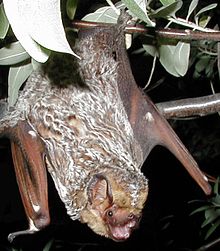Hoary bat
| Hoary bat | |
|---|---|
 |
|
| Scientific classification | |
| Kingdom: | Animalia |
| Phylum: | Chordata |
| Class: | Mammalia |
| Order: | Chiroptera |
| Family: | Vespertilionidae |
| Genus: | Lasiurus |
| Species: | L. cinereus |
| Binomial name | |
|
Lasiurus cinereus (Beauvois, 1796) |
|
 |
|
| Distribution of the hoary bat (2008) | |
The hoary bat (Lasiurus cinereus) is a species of bat in the vesper bat family, Vespertilionidae. It occurs throughout most of North America and much of South America, with disjunct populations in the Galápagos Islands and Hawaii.
The hoary bat averages 13 to 14.5 cm (5.1 to 5.7 in) long with a 40 cm (15.5 in) wingspan and a weight of 26 g (0.92 oz). It is the largest bat normally found in Canada. Its coat is dense and dark brown, with white tips to the hairs that give the species its 'hoary' appearance for which it is named. The body is covered in fur except for the undersides of the wings. The bats can cover an impressive 39 kilometers while foraging.
The bat normally roosts alone on trees, hidden in the foliage, but on occasion has been seen in caves with other bats. It prefers woodland, mainly coniferous forests, but hunts over open areas or lakes. It hunts alone and its main food source is moths.
The reproductive cycle of the hoary bat is not yet fully documented, but it is thought that they mate in August with birth occurring in June of the following year. It is thought that the gestation period is only 40 days and that mammalian embryonic diapause (delayed implantation) may play a role. The female bears a single pup, or sometimes twins. The young spend about a month with the mother before dispersing. The bat is migratory and may travel from Canada as far south as the southern United States or Bermuda. It occasionally roosts inside shipping crates and this may account for reports of the species above the Arctic Circle.
...
Wikipedia

